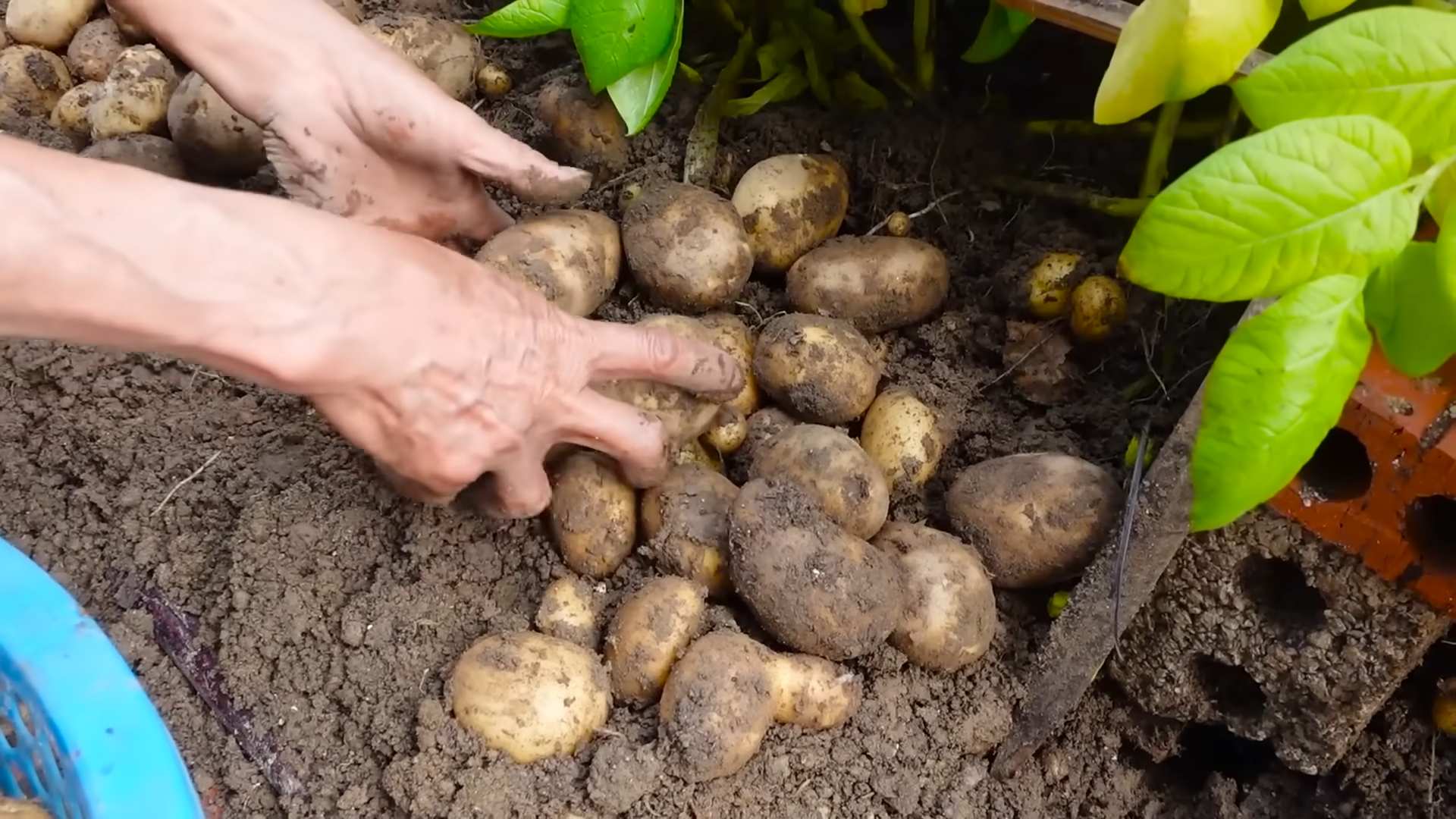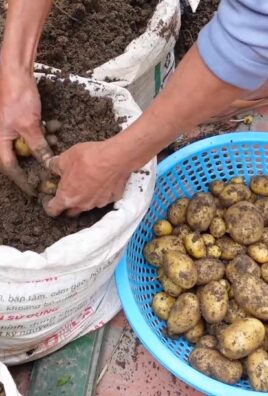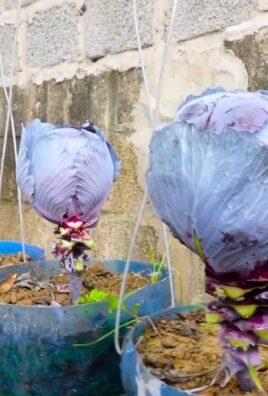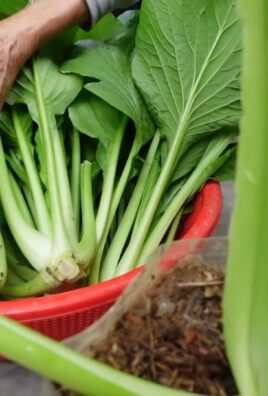Growing potatoes at home might seem daunting, conjuring images of vast fields and complex machinery. But I’m here to tell you that fresh, homegrown potatoes are absolutely within your reach, even if you only have a small balcony or a sunny corner in your backyard! Forget those bland, store-bought spuds – imagine the taste of freshly dug, earthy potatoes, bursting with flavor and nutrients.
Potatoes have a rich history, dating back thousands of years to the Andes Mountains of South America, where they were a staple food for the Inca civilization. They’ve since become a global culinary icon, featuring in countless dishes around the world. But beyond their deliciousness, growing your own potatoes offers a unique connection to this history and a sense of self-sufficiency that’s incredibly rewarding.
Why should you try this DIY trick? Well, for starters, growing potatoes at home allows you to control exactly what goes into your food, avoiding harmful pesticides and ensuring the freshest possible produce. Plus, it’s a fantastic way to get your hands dirty, connect with nature, and enjoy the satisfaction of nurturing something from seed (or in this case, a seed potato!) to harvest. In this article, I’ll share some simple yet effective DIY tricks and hacks that will make growing potatoes at home easier and more successful than you ever thought possible. Get ready to dig in!

Growing Potatoes in Your Backyard: A Beginner’s Guide
Hey there, fellow gardening enthusiasts! Ever dreamt of digging up your own homegrown potatoes, bursting with flavor and freshness? Well, dream no more! Growing potatoes at home is surprisingly easy and incredibly rewarding. I’m going to walk you through everything you need to know, from choosing the right potatoes to harvesting your bounty. Let’s get our hands dirty!
Choosing Your Seed Potatoes
First things first, you can’t just plant any old potato from the grocery store. You need “seed potatoes.” These are potatoes specifically grown for planting and are certified disease-free.
* What are Seed Potatoes? Seed potatoes are essentially potatoes that have been grown specifically to be planted and grown into new potato plants. They are different from the potatoes you buy at the grocery store, which are grown for consumption. Seed potatoes are certified to be disease-free and are more likely to produce a healthy and abundant crop.
* Where to Buy Them: You can find seed potatoes at most garden centers, nurseries, and online retailers. Look for reputable suppliers to ensure you’re getting quality seed potatoes.
* Choosing the Right Variety: There are tons of potato varieties to choose from, each with its own unique flavor, texture, and growing characteristics. Consider your climate, soil type, and personal preferences when selecting your seed potatoes. Some popular varieties include:
* Russet: Great for baking and frying.
* Yukon Gold: All-purpose potato with a buttery flavor.
* Red Potatoes: Waxy texture, perfect for boiling and salads.
* Fingerling Potatoes: Small, elongated potatoes with a delicate flavor.
* Size Matters: You don’t need huge seed potatoes. Smaller ones, about the size of a chicken egg, are perfectly fine. You can even cut larger seed potatoes into smaller pieces, making sure each piece has at least one or two “eyes” (those little buds that sprout).
Preparing Your Seed Potatoes: Chitting (Optional but Recommended)
Chitting, also known as “sprouting,” is the process of encouraging your seed potatoes to sprout before planting. This gives them a head start and can result in an earlier and larger harvest.
* Why Chit? Chitting helps your potatoes develop strong sprouts, which means they’ll emerge from the soil faster and be more resistant to pests and diseases.
* How to Chit:
1. Place your seed potatoes in a cool, bright, and frost-free location. An egg carton or a shallow tray works well.
2. Arrange the potatoes with the “eyes” facing upwards.
3. Allow the potatoes to sit for 4-6 weeks, or until the sprouts are about 1-2 inches long.
4. Rotate the potatoes occasionally to ensure even sprout growth.
Preparing Your Planting Site
Potatoes need plenty of sunlight and well-drained soil. Choose a location that gets at least 6-8 hours of sunlight per day.
* Soil Preparation: Potatoes prefer slightly acidic soil with a pH of 6.0-6.5. Amend your soil with compost or well-rotted manure to improve drainage and fertility. Remove any rocks or debris that could hinder root growth.
* Trenching: Dig trenches that are about 6-8 inches deep and 2-3 feet apart. This will give your potatoes plenty of room to grow.
Planting Your Seed Potatoes
Now for the fun part – planting!
1. Space Your Potatoes: Place your seed potatoes (or potato pieces) in the trenches, spacing them about 12 inches apart. Make sure the sprouts are facing upwards.
2. Cover with Soil: Cover the seed potatoes with about 4 inches of soil.
3. Water Well: Water the area thoroughly to help the potatoes settle in.
Hilling Your Potatoes
Hilling is a crucial step in growing potatoes. It involves gradually mounding soil around the potato plants as they grow.
* Why Hill? Hilling encourages the potatoes to produce more tubers along the buried stems. It also protects the developing potatoes from sunlight, which can cause them to turn green and produce solanine, a toxic compound.
* How to Hill:
1. When the potato plants are about 6-8 inches tall, use a hoe or shovel to gently mound soil around the base of the plants, covering about half of the stems.
2. Repeat this process every 2-3 weeks as the plants continue to grow, until the mounds are about 12 inches high.
3. You can also use other materials for hilling, such as straw, hay, or shredded leaves.
Watering and Fertilizing
Potatoes need consistent moisture, especially during tuber formation.
* Watering: Water deeply and regularly, especially during dry spells. Aim for about 1-2 inches of water per week. Avoid overwatering, which can lead to rot.
* Fertilizing: Potatoes are heavy feeders, so they benefit from regular fertilization. Use a balanced fertilizer (e.g., 10-10-10) or a fertilizer specifically formulated for potatoes. Apply the fertilizer according to the package instructions. You can also side-dress your plants with compost or well-rotted manure.
Pest and Disease Control
Potatoes can be susceptible to various pests and diseases.
* Common Pests:
* Colorado Potato Beetles: These beetles can defoliate your potato plants. Handpick them off the plants or use an insecticide specifically labeled for potato beetles.
* Aphids: These tiny insects suck sap from the plants. Spray them with insecticidal soap or neem oil.
* Potato Leafhoppers: These insects can cause stunted growth and leaf damage. Use row covers to protect your plants or spray them with an insecticide.
* Common Diseases:
* Early Blight: This fungal disease causes dark spots on the leaves. Remove infected leaves and spray the plants with a fungicide.
* Late Blight: This devastating disease can quickly destroy your potato crop. Choose disease-resistant varieties and spray the plants with a fungicide.
* Scab: This disease causes rough, scabby lesions on the potatoes. Avoid planting potatoes in alkaline soil and use disease-free seed potatoes.
* Prevention is Key: Practice good garden hygiene to prevent pests and diseases. Rotate your crops, remove weeds, and keep your plants well-ventilated.
Harvesting Your Potatoes
The moment we’ve all been waiting for! Knowing when to harvest your potatoes is key to getting the best flavor and yield.
* When to Harvest:
* New Potatoes: These are small, immature potatoes that are harvested early in the season. You can start harvesting new potatoes about 2-3 weeks after the plants flower. Gently dig around the base of the plants and harvest a few potatoes at a time.
* Mature Potatoes: These are larger, more mature potatoes that are harvested later in the season. Wait until the potato plants have flowered and the foliage has started to die back. This usually takes about 80-100 days after planting.
* How to Harvest:
1. Use a garden fork or shovel to carefully dig around the potato plants.
2. Gently lift the plants out of the soil, being careful not to damage the potatoes.
3. Remove the potatoes from the soil and brush off any excess dirt.
Curing and Storing Your Potatoes
Curing and storing your potatoes properly will help them last longer.
* Curing:
1. Spread the potatoes out in a single layer in a cool, dark, and well-ventilated location.
2. Allow the potatoes to cure for about 1-2 weeks. This will help the skins to harden and heal any minor cuts or bruises.
* Storing:
1. Store the cured potatoes in a cool, dark, and dry location with good ventilation. A root cellar or basement is ideal.
2. The ideal storage temperature is between 40-50°F (4-10°C).
3. Avoid storing potatoes near apples or onions, as these fruits and vegetables release ethylene gas, which can cause the potatoes to sprout.
4. Check the potatoes regularly for signs of rot or spoilage. Remove any damaged potatoes to prevent the spread of disease.
Enjoying Your Homegrown Potatoes
Congratulations! You’ve successfully grown your own potatoes. Now it’s time to enjoy the fruits (or rather, tubers) of your labor.
* Cooking Ideas: The possibilities are endless! Bake them, fry them, boil them, mash them, roast them – you name it! Homegrown potatoes taste so much better than store-bought ones.
* Sharing the Bounty: Don’t forget to share your harvest with friends and family. They’ll be amazed by your gardening skills!

Conclusion
So, there you have it! Growing potatoes at home, especially using the container method, is not just a gardening project; it’s a rewarding experience that puts fresh, flavorful potatoes right at your fingertips. Forget the supermarket spuds that have traveled miles and lost their zest. Imagine the satisfaction of harvesting your own homegrown potatoes, knowing exactly where they came from and how they were nurtured.
This DIY trick is a must-try for several compelling reasons. First and foremost, it’s incredibly space-efficient. Whether you have a sprawling garden or just a small balcony, container gardening allows you to cultivate potatoes virtually anywhere. Second, it offers superior control over the growing environment. You can tailor the soil composition, watering schedule, and sun exposure to optimize potato growth. Third, harvesting is a breeze! No more digging through endless rows of soil; simply tip the container and collect your bounty.
But the benefits don’t stop there. Growing your own potatoes is also a fantastic way to reduce your carbon footprint and support sustainable food practices. You’re cutting down on transportation emissions and avoiding the use of potentially harmful pesticides and herbicides. Plus, it’s a fun and educational activity for the whole family!
Ready to take your potato growing to the next level? Consider these variations:
* Experiment with different potato varieties: From the classic Russet to the vibrant Yukon Gold and the petite fingerling potatoes, each variety offers a unique flavor and texture. Try growing a mix of varieties to add diversity to your meals.
* Add companion plants: Marigolds, basil, and nasturtiums can help deter pests and attract beneficial insects to your potato plants.
* Try using different containers: While grow bags are a popular choice, you can also use large buckets, trash cans, or even repurposed tires. Just make sure the container has adequate drainage.
* Explore vertical gardening: Stackable planters or potato towers can maximize space and create a visually stunning display.
Don’t be intimidated if you’re a beginner gardener. Growing potatoes at home is surprisingly easy, and the rewards are well worth the effort. With a little patience and attention, you’ll be enjoying delicious, homegrown potatoes in no time.
We encourage you to give this DIY trick a try and share your experience with us! Post photos of your potato plants, tell us about your favorite varieties, and let us know what challenges you encountered and how you overcame them. Your insights can help other aspiring potato growers succeed. Let’s build a community of passionate gardeners who are committed to growing their own food and enjoying the simple pleasures of life. So, grab some seed potatoes, find a suitable container, and get ready to embark on a rewarding gardening adventure! Happy growing!
Frequently Asked Questions (FAQ)
What kind of potatoes should I use for seed potatoes?
You’ll want to use certified seed potatoes, which are potatoes specifically grown for planting. These are disease-free and will give you the best chance of a successful harvest. You can find them at most garden centers or online retailers. Avoid using potatoes from the grocery store, as they may have been treated to prevent sprouting or may carry diseases. If you absolutely must use grocery store potatoes, choose organic ones and look for those that have already started to sprout. Cut larger seed potatoes into pieces, ensuring each piece has at least one “eye” or sprout. Let the cut pieces dry for a day or two before planting to prevent rotting.
How much sunlight do potatoes need?
Potatoes need at least six to eight hours of direct sunlight per day to thrive. Choose a location that receives plenty of sunlight throughout the growing season. If you’re growing potatoes in containers, you can move them around to ensure they get enough sun. Insufficient sunlight can result in smaller potatoes and a reduced harvest.
What kind of soil is best for growing potatoes?
Potatoes prefer well-draining, slightly acidic soil with a pH between 6.0 and 6.5. A loamy soil that is rich in organic matter is ideal. You can amend your soil with compost, aged manure, or other organic materials to improve its fertility and drainage. Avoid heavy clay soils, as they can become waterlogged and inhibit potato growth. When growing in containers, use a high-quality potting mix specifically formulated for vegetables.
How often should I water my potato plants?
Water your potato plants regularly, especially during dry periods. Keep the soil consistently moist but not waterlogged. Overwatering can lead to root rot and other fungal diseases. Check the soil moisture by sticking your finger about an inch deep. If the soil feels dry, it’s time to water. Water deeply and thoroughly, allowing the water to reach the roots. Reduce watering as the plants begin to die back in preparation for harvest.
How do I “hill” my potato plants?
Hilling is the process of adding soil around the stems of your potato plants as they grow. This encourages the plants to produce more potatoes along the buried stems. Start hilling when the plants are about 6 inches tall. Gently mound soil around the stems, leaving the top few leaves exposed. Repeat this process every few weeks as the plants grow, until the container is nearly full.
When are potatoes ready to harvest?
The timing of your potato harvest will depend on the variety you’re growing and the growing conditions. Generally, potatoes are ready to harvest when the plants begin to flower or when the foliage starts to turn yellow and die back. You can harvest “new potatoes” (small, immature potatoes) a few weeks after flowering. For mature potatoes, wait until the foliage has completely died back before harvesting. To harvest, gently dig around the base of the plant and lift the potatoes out of the soil.
What are some common potato pests and diseases?
Some common potato pests include potato beetles, aphids, and flea beetles. Diseases that can affect potatoes include blight, scab, and root rot. You can prevent pest and disease problems by using disease-free seed potatoes, practicing crop rotation, and maintaining good soil drainage. If you encounter pests or diseases, you can use organic pest control methods or fungicides to manage them.
Can I grow potatoes in the same container year after year?
It’s generally not recommended to grow potatoes in the same container year after year, as this can deplete the soil of nutrients and increase the risk of disease. It’s best to rotate your crops and use fresh potting mix each year. If you must reuse the same container, amend the soil with plenty of compost and other organic matter to replenish nutrients.
How do I store my harvested potatoes?
Store your harvested potatoes in a cool, dark, and well-ventilated place. A root cellar is ideal, but a basement or garage can also work. Avoid storing potatoes in the refrigerator, as this can cause them to develop a sweet taste. Store potatoes away from apples and bananas, as these fruits release ethylene gas, which can cause potatoes to sprout prematurely. Properly stored potatoes can last for several months.





Leave a Comment